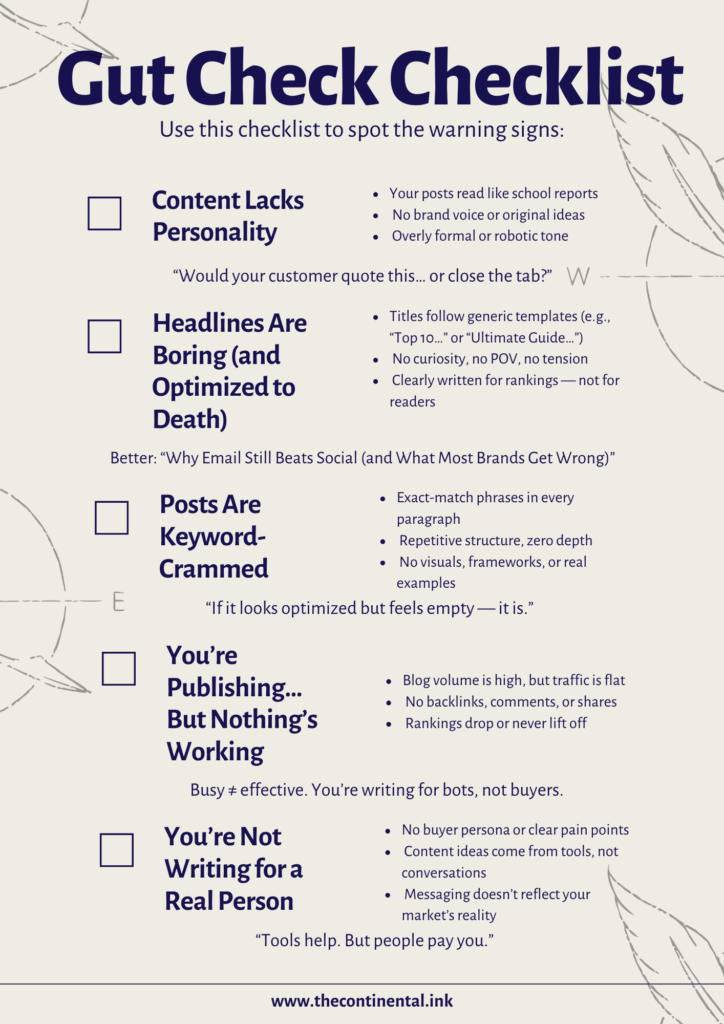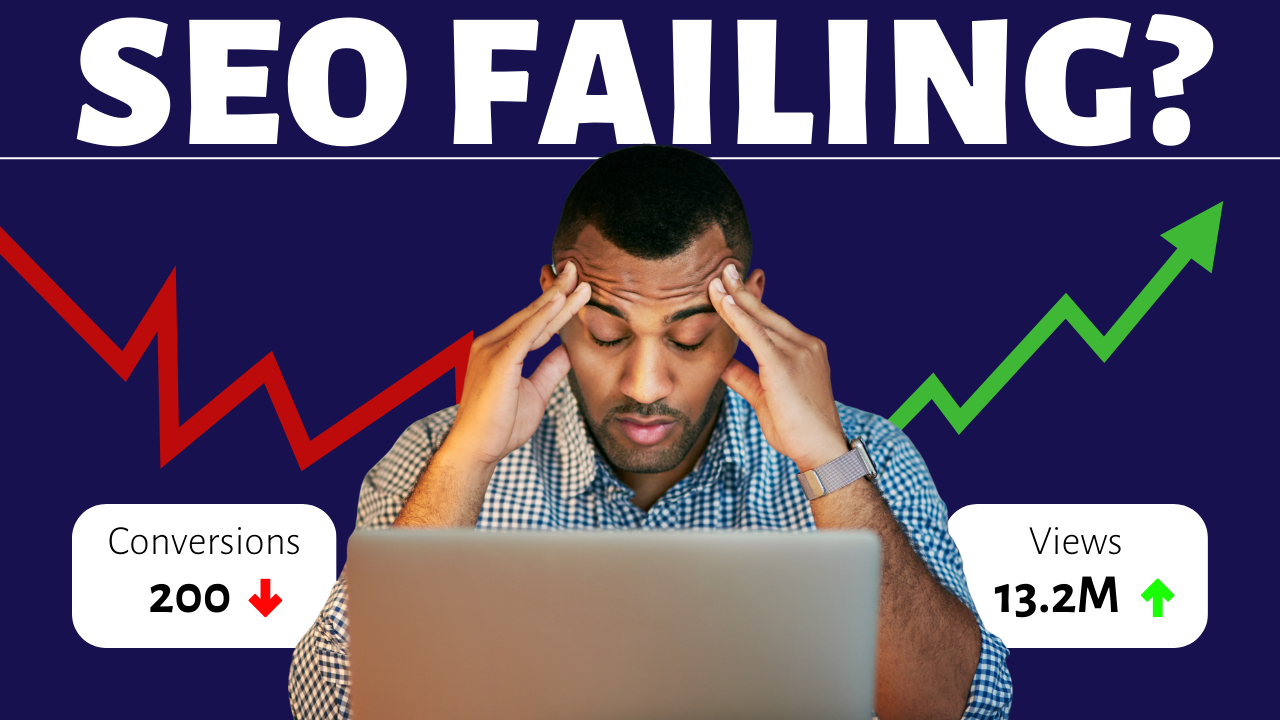You’ve researched keywords. Nailed your meta descriptions. Published a stack of SEO-optimized blog posts.
But traffic? Still flat.
Here’s the hard truth: SEO-first publishing often sounds like a solid strategy — but in practice, it rarely drives meaningful results. Why? Because optimizing for search engines at the expense of the reader is a fast track to irrelevance.
Let’s break down why SEO-first publishing fails — and what to do instead if you want to actually grow.
TL;DR: Why SEO-First Publishing Fails
SEO-first content may rank, but it rarely resonates. It often ignores user intent, lacks depth, and sounds robotic — leading to poor engagement and fragile traffic. To succeed long-term, balance SEO with human-focused content that solves real problems, builds trust, and drives action.
What Is SEO-First Publishing?
SEO-first publishing is a content strategy built primarily around keyword optimization. It looks like this:
- Start with high-volume keywords
- Build content around those keywords
- Optimize for rankings (titles, headings, URLs, alt text, etc.)
- Prioritize SEO metrics over audience needs
The end goal? Rank higher. Drive more organic traffic.
But here’s the disconnect:
Ranking ≠ Relevance.
Traffic that bounces doesn’t convert. Rankings without engagement don’t grow a brand.
Why SEO-First Publishing Fails (Even If It Ranks)

SEO-first publishing can get your content on page one.
But staying there? Turning that visibility into leads or loyalty? That’s where it breaks.
Let’s break down where this approach falls short — and how it quietly sabotages your content ROI.
1. It Creates Hollow Content
SEO-first content is often:
- Keyword-stuffed instead of insightful
- Over-optimized but underwhelming
- Generic to the point of invisibility
You can game your way into rankings — but not into relevance.
What happens:
- Visitors bounce fast
- No backlinks or shares
- Google sees low engagement and drops your ranking
For example, a post titled “What Is Marketing Automation?” that just defines the term for 800 words with no examples, frameworks, or next steps — that’s content with no edge.
2. It Misses Intent (And Loses the Reader)
SEO-first strategies focus on what people search, not why they search.
|
Name
|
Age
|
Phone
|
|---|---|---|
|
Keyword
|
best coffee maker
|
|
|
SEO-First Result
|
A basic list of 10 coffee makers
|
|
|
User Intent
|
Which one fits my $100 budget and tiny kitchen?
|
If you ignore the why, your content won’t satisfy — and Google’s getting much better at detecting that mismatch.
Business impact:
- High bounce rate
- Low conversions
- Content that doesn’t drive decision-making
3. It Feels Robotic (And People Can Tell)
Your content shouldn’t read like a checklist from an SEO tool.
Dead giveaways:
- Repetitive phrasing with exact-match keywords
- Awkward transitions
- No opinion, no personality, no story
Readers don’t return to generic content. They remember what made them feel seen or smarter.
Missed opportunity: You don’t build brand affinity if your content sounds like it could belong to any of your competitors.
4. It Makes You Algorithm-Dependent
SEO-first strategies make you fragile.
When rankings drop, so does your traffic — because there’s no brand loyalty, no direct traffic, and no real audience.
What makes it worse?
- Google’s constant algorithm shifts
- The rise of AI search (less real estate for organic results)
- Content saturation across every niche
If your traffic graph lives and dies by rankings, your strategy isn’t resilient.
Brands that win long term:
- Earn direct visits because people trust them
- Build communities that engage, refer, and convert
- Use SEO to support growth — not depend on it
Bottom line: SEO-first publishing might check technical boxes, but it fails where it matters most: connection, differentiation, and long-term brand growth.
The Fix: Balance SEO with Editorial Strategy
Don’t ditch SEO — reposition it.
Use it as a tool to inform, not dictate, your content. Here’s how:
✅ Start with People, Not Keywords
- Talk to your customers.
- Review sales calls, chat logs, community comments.
- Use keyword data to validate, not define, what matters.
For example, instead of writing for “best CRM software,” create content that answers, “How do I choose a CRM that doesn’t waste my team’s time?”
✅ Outline for Value, Not Density
Build your post around a complete, logical flow:
- What problem are you solving?
- What does your reader need to know?
- Where are they in the buyer journey?
Then layer SEO elements after the core is solid.
✅ Write for Humans, Edit for Bots
Focus on:
- Clear, helpful headlines
- Scannable structure (short paragraphs, bullet points)
- Voice that sounds like a person, not a plugin
Optimize your:
- Title tag to reflect intent
- Meta description to preview value
- H1/H2s to align with user questions
✅ Track What Matters
- Look at time on page, bounce rate, and repeat visits — not just rankings.
- Read comments and emails. Are people thanking you? Quoting you? Sharing your link?
If it resonates, it ranks. If it ranks but doesn’t resonate — it won’t for long.
How to Tell If You’re Stuck in an SEO-First Content Strategy

Most brands don’t realize they’re stuck in SEO-first mode. The content looks “fine” on paper — it’s optimized, the blog is active, keywords are in place.
But it still underperforms.
Here are clear signs your content is optimized for bots, not buyers:
1. Your Blog Feels Like a Wikipedia Factory
- Overly formal tone, no brand personality
- Every post sounds like a school report
- Lists facts, but doesn’t say anything original
Ask yourself: Would your customer quote this post or close the tab?
2. Headlines That Check Boxes, Not Spark Curiosity
- Titles like “10 Benefits of Email Marketing” or “Best CRM Tools 2024”
- No angle, no tension, no POV
- Clearly written for search engines — not humans
Better: “Why Email Marketing Still Beats Social (and What Most Brands Get Wrong)”
3. Posts Crammed with Keywords… and Nothing Else
- Exact match phrases stuffed in every paragraph
- Repetition without real depth
- No images, frameworks, or examples to break up text
This is how your bounce rate gets bloated.
4. You’re Publishing Often — But Nothing Is Performing
- Blog output is high, but traffic is flat
- Few backlinks, shares, or comments
- Search rankings either plateau or fade quickly
Red flag: You’re busy, but not effective.
5. You Have No Idea Who You’re Actually Writing For
- No clear buyer persona or pain points mapped
- No messaging framework
- Topic ideas come from tools, not people
Tools are helpful — but people pay you.
Quick Gut Check
- Do your blog posts sound like your brand, or like AI?
- Would a first-time visitor trust you after reading them?
- Would you email this post to a potential client?
If you’re hesitating…It’s time for a strategic reset.
How to Recover from an SEO-First Content Strategy
If your content feels like it was written for bots, not buyers — don’t panic. You’re not starting from scratch. You’re just course-correcting.
Here’s how to rebuild smarter:
1. Audit Your Existing Content (with Intent in Mind)
Start with your blog archive and identify which posts:
- Aren’t driving traffic (check Google Search Console or GA4)
- Have high bounce rates or low time on page
- Feel generic, keyword-stuffed, or disconnected from your audience’s real questions
For example, a blog post titled “Best Marketing Tools 2024” that’s just a bullet list of tools without commentary, use cases, or differentiation? That’s thin. Flag it.
Next Step: Use a content audit sheet. Add columns for URL, goal, target keyword, user intent, traffic, bounce rate, and content quality (1–5 scale).
2. Improve or Unpublish Ruthlessly
Every post should earn its place on your site.
- Update if the topic is still relevant but the content is weak or outdated
- Merge posts that target the same topic with scattered content
- Unpublish low-value posts that serve no strategic or search purpose
Have five short blogs about “email subject lines”? Combine them into one authoritative guide with real examples, frameworks, and updated insights.
Next Step: Set up redirect rules for removed posts (301 redirects) to avoid losing any link equity.
3. Rebuild with Usefulness, Then Optimize
Flip your workflow:
- Start with the user problem
- Solve it with clear, actionable content
- Optimize after it’s valuable
Instead of writing for “SEO tips for small business,” write for the problem: “Why isn’t my blog driving traffic?” That’s what your reader is actually Googling, even if the keyword isn’t an exact match.
Next Step: Use keyword tools (like Ahrefs or Semrush) to validate demand after defining the topic — not before.
4. Define Your Brand Voice and Point of View
Too many SEO-first blogs sound like they were all written by the same person: nobody.
- Document your voice: Are you casual? Authoritative? Witty?
- Clarify your POV: What do you believe that others in your space overlook?
Instead of saying, “Email marketing is important,” say, “If your emails still feel like a newsletter from 2010, your unsubscribe rate will prove it.”
Next Step: Create a simple tone and voice guide with writing samples, do’s/don’ts, and brand beliefs. Share it with your team or writers.
5. Track the Right Metrics Moving Forward
Your goal isn’t just to rank. It’s to connect, convert, and retain.
Start tracking:
- Time on page
- Scroll depth
- Email signups
- Return visitors
- Shares or backlinks
- Comments or replies
These metrics signal to Google (and to you) that your content actually works.
Next Step: Set up event tracking in GA4 or tools like Hotjar to monitor user behavior beyond pageviews.
Frequently Asked Questions
What is SEO-first publishing?
SEO-first publishing is a strategy where content is created primarily to rank in search engines by targeting keywords and optimizing on-page elements—often at the cost of user value or intent.
How do I know if my content strategy is too SEO-first?
Look for red flags like high bounce rates, low time on page, few shares or backlinks, and content that feels repetitive or robotic. If users don’t engage, it’s a signal to pivot.
What’s the risk of keyword stuffing today?
Keyword stuffing leads to poor readability and can trigger Google penalties. Modern algorithms prioritize relevance, clarity, and experience—keyword abuse does more harm than good.
Can I recover from an SEO-first content strategy?
Yes. Start by auditing existing posts, identifying thin or irrelevant content, and rewriting for clarity, originality, and value. Prioritize helpfulness over keyword density moving forward.
What are better signals than keyword density for SEO success?
Focus on user engagement: time on page, scroll depth, click-through rates, and backlinks. These metrics reflect real value—and Google increasingly uses them to rank content.
How often should I audit my content for quality?
Aim to audit your top-performing and aging posts quarterly. Evaluate intent alignment, content depth, accuracy, and engagement. Refresh outdated info and retire underperformers.
Can small brands compete without aggressive SEO tactics?
Absolutely. Niche brands win by deeply understanding their audience, solving specific problems, and creating content that’s authentic, useful, and memorable. Trust > traffic volume.
How do I balance SEO with creativity and voice?
Lead with clarity, not complexity. Build content around real user questions, then optimize gently. Keep your brand voice human—search engines are rewarding authenticity more than ever.
Serve Humans First. Search Will Follow.
SEO-first publishing fails because it puts the algorithm before the audience. But content that prioritizes clarity, value, and trust? That’s the stuff search engines — and actual people — reward.
If you’re building a long-term content strategy, here’s your play:
Start with humans. Back it with data. Optimize last.
Need help realigning your content strategy? Let’s talk.






